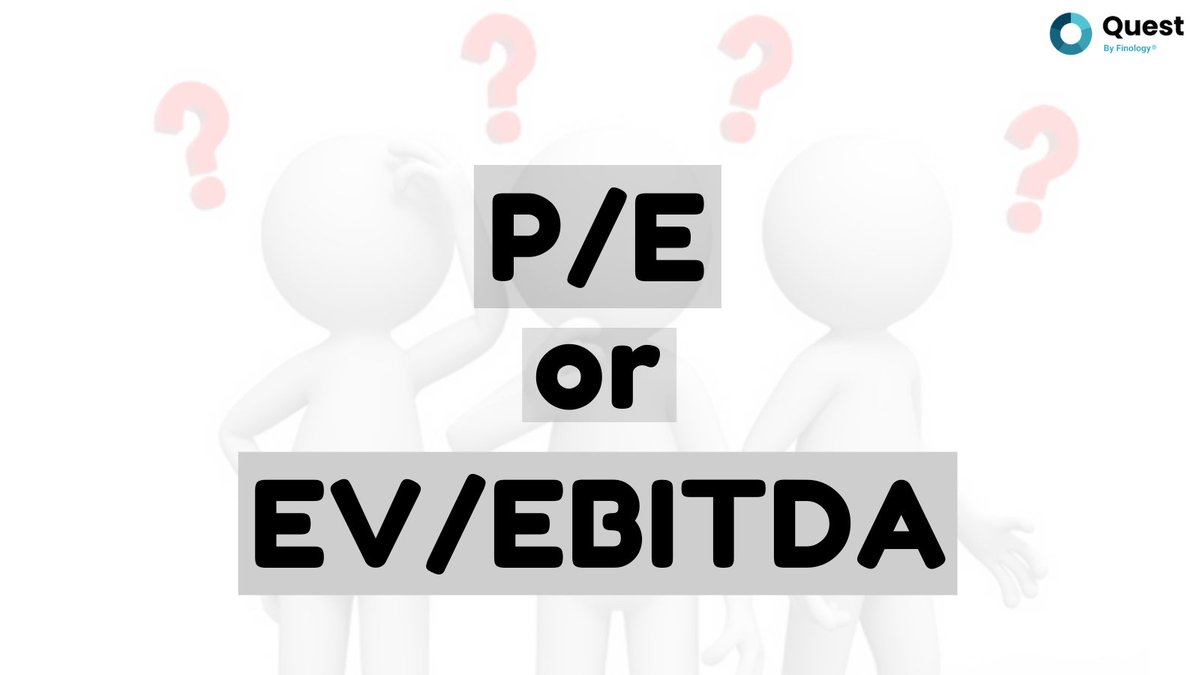
Which is a better measure of Valuation P/E or EV/EBITDA??? (1/17)
- Ek dhaaga 🧵
#StockMarket #investing #finance
- Ek dhaaga 🧵
#StockMarket #investing #finance

While valuing companies analysts use different methods to determine if a particular company is undervalued or overvalued. And two most commonly used ratios are the P/E ratio and EV/EBITDA ratio.
Before understanding which one is better let’s understand these ratios. (2/17)
Before understanding which one is better let’s understand these ratios. (2/17)
The first is the P/E ratio, it is calculated as Share price/Earnings per share, it measures the money that investors are willing to pay for every rupee a company earns.
What are the drawbacks of the P/E #Ratio? (3/17)
What are the drawbacks of the P/E #Ratio? (3/17)
Price to earnings compares the price of a share with that of earnings that are available to shareholders (EPS), so it measures only the equity value of the company and ignores the debt component, so companies that normally have high debt get low P/E ratios. (4/17)
Second, the P/E ratio is influenced by the market perceptions because the price of a share is determined by the investors and therefore some companies may get a higher valuation than others. (5/17)
For example, companies that are in high growth sectors and have disruptive potential may get a high valuation or companies that have good brand value and reputed management may be valued higher than peers. (6/17)
The third is P/E Ratio by itself does not convey much unless it is also looked at with reference to growth. (7/17)
EV/EBITDA ratio
This ratio has two components: EV and EBITDA. EV, or enterprise value, is the total value of a company that someone had to pay if they had to acquire the firm.
Enterprise Value = Market value of equity + Market value of Debt – Cash on hand
(8/17)
This ratio has two components: EV and EBITDA. EV, or enterprise value, is the total value of a company that someone had to pay if they had to acquire the firm.
Enterprise Value = Market value of equity + Market value of Debt – Cash on hand
(8/17)
Let’s understand it with an example, say you want to buy a shop which is selling at Rs. 10,00,000. The seller of the shop has taken a loan of Rs. 2,00,000 for the maintenance of the shop, which you would have to pay in case you acquire the shop.... (9/17)
Also, the shop has tijori which has around 3,00,000 cash, which you would get in case you buy the shop. So the actual value or enterprise value of your acquisition would be Rs.10,00,000 + Rs. 2,00,000 - Rs. 3,00,000 = Rs. 9,00,000.
(10/17)
(10/17)
The other part of the metric is the EBITDA, which is also known as the operating pft. It is the earning before interest cost, tax, depreciation & amortisation, & appears in the firm’s income statement. Other way is by adding depreciation, int cost & tax to net earning. (11/17)
EV/EBITDA basically tells you the payback period of your investments, say the EV of a company is Rs. 2000 cr and annual earnings ( EBITDA ) of a company is Rs. 200 cr, it implies that the firm can repay its entire cost of acquisition to the buyer in 10 years. (12/17)
Which one is better?
P/E is a good measure for valuing the equity of the company. Since it considers the residual profit (EPS) as the denominator, EV/EBITDA is a better measure of valuation, especially when one is looking at mergers and acquisitions. (13/17)
P/E is a good measure for valuing the equity of the company. Since it considers the residual profit (EPS) as the denominator, EV/EBITDA is a better measure of valuation, especially when one is looking at mergers and acquisitions. (13/17)
EV/EBITDA is ideal for valuing companies in the telecommunication, cement & steel sector as companies in these sectors carry a high debt in their balance sheets and have high gestation periods. (14/17)
EV/EBITDA is also a better measure when valuing companies that are making losses at net earnings level, while their operating profits are positive. (15/17)
P/E ratio is a better measure while valuing companies in the industries, where the growth is high and the industry is not capital intensive such as IT. (16/17)
• • •
Missing some Tweet in this thread? You can try to
force a refresh












